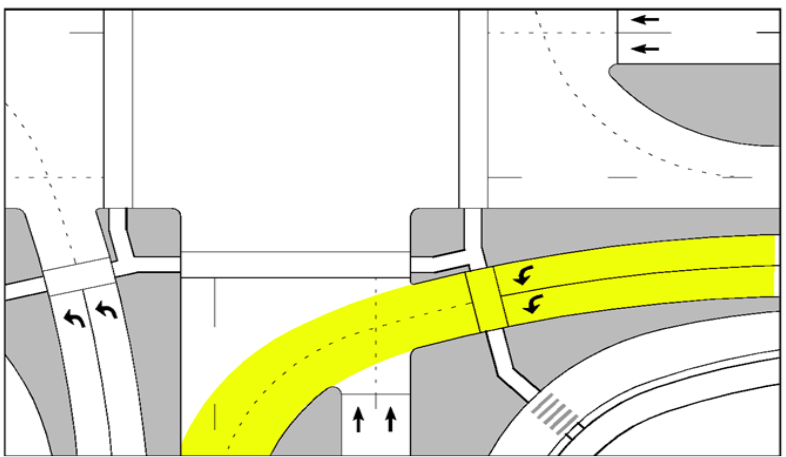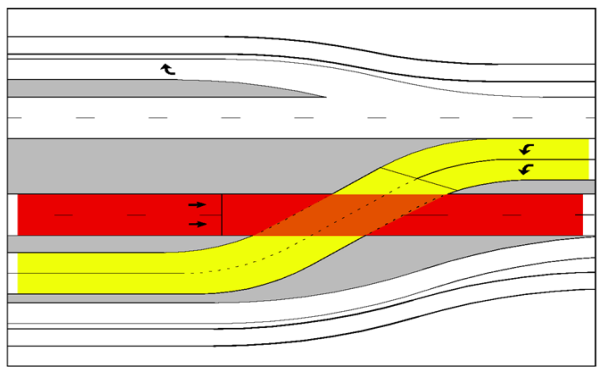14.7.2 Design Considerations
The distance between the main intersection and the crossovers should generally range from 300-ft to 500-ft. Shorter spacing may result in queue spillback and reduce the ability to clear queues through a single signal cycle phase. Longer spacing may result in greater difficulty in coordinating signal operations. See
for a depiction of typical intersection spacing.

Figure 14-26: DLT Typical Intersection Spacing
Source: FHWA DLT Informational Guide
At the main intersection, the primary objective is to provide appropriate turning paths for the displaced left-turns, considering the interaction with sidewalks. Side-by-side check vehicles are not typically accommodated but can be if the context of the intersection has a high frequency use of check vehicles. The vehicle paths for the displaced left-turns through the main intersection will delineate the curb lines and stop bar (a.k.a. stop line) locations and determine the width of the overall intersection as shown in
.

Figure 14-27: DLT Left-Turn Maneuvers
Source: FHWA DLT Informational Guide
For the crossover intersection, the main objective is to provide a smooth alignment for the traffic and not introduce back-to-back reverse curves along the travel paths. The goal is to align the left-turns at the stop bar with the receiving lanes to reflect desirable vehicle path alignment to minimize path overlap as shown in
.
It is desirable to provide the largest crossing angle while adapting to each site’s unique conditions. Early design practice targeted crossover angles of 45 degrees or greater to facilitate proper vehicle path alignment through the crossover and reduce the likelihood of wrong-way movements. It is often difficult to achieve 45 degrees in practice. Several factors influence cross angle selection:
- Wrong-way maneuvers —Minimizing the likelihood of a wrong-way maneuver into opposing traffic is a key consideration. The greater the crossing angle, the more the intersection will appear conventional and support use of the crossover; and
- ROW constraints —The surrounding environment will influence a configuration. For instance, a retrofit design may be constrained by ROW.

Figure 14-28: DLT Crossover Intersection Geometry
Source: FHWA DLT Informational Guide
Additionally, there are two ways to accommodate the geometry where the right-turn bypass lane joins the crossroad through lanes:
- Provide an additional lane with a downstream merge; or
- Signalize the movement and operate it as part of the crossover signal.
For more detailed information on the geometric design of a DLT intersection refer to Chapter 7 of the
, Sight Distance.
Provide appropriate sight distance and lighting for approaching motorists to see activity at the crosswalk, as well as sight distance for pedestrians to see oncoming traffic. Stopping sight distance for the approaching motorists and sight distances for the pedestrians approaching the potential oncoming automobiles must be clear of obstructions and provide sufficient visibility for various users.